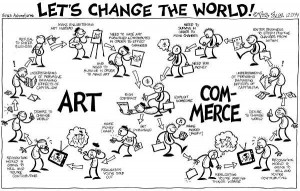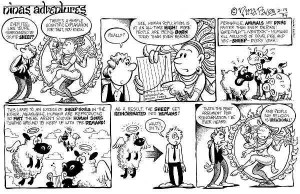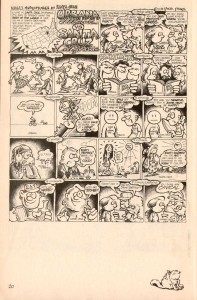This is part of a roundtable on copyright and free culture issues. You can read the whole Cuckoo for Copyright roundtable here.
=================================
Previously, Part 1.
So that’s a pretty good segue into talking about Sita. You’d talked about how traumatic it was to realize that the film was illegal. Can you tell me a little bit more about how you found it out, what specifically was wrong, and what it meant to get it decriminalized?
It’s not so much that I realized – I mean, I knew that I was using stuff that I did not have permission to use. But it should have been public domain. I knew that it should have been public domain. I learned that part of it was public domain and part of it was not, and the realization was not so much “oh, I don’t have permission for this.” The realization was the severity of the penalties, and how much more severe the penalties have grown in the last 10 years. Realizing that, wow, I could go to jail for making this film. That was impressive! And it’s all because of these law changes thanks to the industry reacting to the advent of the Internet and really cracking down, and it was like, “wow, I could go to jail.”
If you didn’t pay?
It’s not even if I didn’t pay. There was this dawning realization that getting permission was this Kafkaesque nightmare. Because before that, it was like, oh well, I’ll just pay. They’ll say some amount and I’ll pay. I could not have imagined the difficulty of even talking to them. They wouldn’t even answer my calls. So I think that after a few months of getting the runaround from all of them and not having our calls returned, and being told to call other places and then that went nowhere, while reading about the severity of the punishments, maybe it just took a couple of months, April-May of 2008, when I’d been working on this for a few months and realizing There is No Way Out. They’re not going to talk to me. They don’t have to talk to me. The burden is on me. If their deal is that they only talk to you if you hire a paid intermediary, I have to hire an intermediary to talk to them. I have to do this stuff that I can’t afford to do, and I’d better do it, because if I don’t, I could go to jail [laughs] not to mention being fined zillions of dollars.
So it wasn’t a sudden moment, it was a long gradual slow sinking feeling.
Was it pretty easy to find out at the beginning which pieces were copyrighted and which pieces weren’t?
Well, it was possible to find out. I knew that her voice was not the problem, thanks to the student attorneys at American University.
But someone else did that research; you couldn’t do that on your own.
No, there’s no way I could have done it, but at least they did it for free. And they did all this extensive research on the recordings, and we found that the recordings were not a big problem, and that the underlying compositions were under copyright. I knew that from the beginning, but I could not have imagined that it would be that difficult to clear them. I really thought they’d just name some reasonable number, ‘cause they want money, right? They’ve gotta be – everything I’ve heard about these companies is that they’re interested in money, so clearly they’d set something up so they could get money, right? They wouldn’t ask someone who doesn’t have money to pay $220,000 because there’s no way they’re going to get that! That’s why there’s the whole statutory rate for mechanical licenses. I learned that the statutory rate exists because the record industry lobbied for it, because too many labels wanted their artists to record covers that were the property of other publishers, so it was the record industry that got the statutory licenses for the benefit of the record industry. So the licensors were just crazy; there was no way they were going to get this $220,000 they quoted, and that’s fine with them. It was just this dawning understanding that if no one gets to see my film, that’s fine with them. They don’t have anything to gain from my going forward. It’s not worth the trouble to them, but I could go to jail. I could go to fucking jail.
So as the technology to do things with culture has gotten more democratic they’ve gotten more draconian in almost every way.
Yes. This is like a mafia shakedown. Copyrights were always designed for publishers, not authors – you should read this great essay by Karl Fogel about the history of copyright – but they’re a monopoly for publishers and the argument that publishers used to get this monopoly is “look at this writer. How is this writer going to get money? They’re going to get money by selling us their rights. First we give them a right, and then they sell it to us and then we get a monopoly, yay!”
This is so utterly irrational and unreasonable. It’s something that was supposed to be in the public domain, and if the cultural work is lost, they don’t care. They don’t give a shit about my film, or the songs they “own.” So what I’m supposed to do is kill the film. That’s every message I’m getting: the whole structure is designed for me to kill the film. That is the only possible outcome of this. So then I was like, ok, this is censorship. If the system is designed for me to kill my film, this is censorship. And it was a long struggle, let me tell you. Many tears were shed; I felt so trapped.
You found lawyers who were willing to negotiate this?
I had a sales agent who is a lawyer. I didn’t end up using him in that respect, but his firm – he was trying to get it sold to a distributor and the distributors required that everything was cleared first, and the burden of that fell on me. So initially I used his law firm which was phenomenally expensive and also they did a terrible job. But at least the companies talked to them, because they knew the name. So we got the initial estimates from the companies, and for the mere $10-15K or whatever I ended up paying this law firm, I got to learn that $220,000 was what I would have to pay to clear the rights.
But you didn’t end up paying the $220,000.00; you ended up paying in the range of $50K. What would have been different if you’d paid the $220,000.00?
Then it would be free and clear. Then I would not be required to pay additional money for every 5000 copies sold. I have to make additional payments now, for every 5000 copies sold.
If someone makes a derivative work and they use the songs, can they pay the fees listed on your website, or do they have to negotiate their own?
They have to renegotiate their own licenses. The only thing that my license fees pay for is the cost of a copy, any copy that is sold, a DVD or the iPhone app. If you sell an iPhone app of a movie, you have to pay those fees, which means that the iPhone app is either very expensive or free.
So if someone downloads the film and uses the sound, they’re going to have to call and get their own agreement.
Right, it is a copyleft work that contains copyright stuff. And the copyright stuff will probably be unfree forever, so any reuse of the songs has to be relicensed. You could certainly use all of it without the songs. And some of the modern songs are copyleft now as well; you can make derivative works with all of the soundtrack works except the Rudresh Mahanthappa songs and the Annette Hanshaw songs.
I had one question about Sita itself. The first time I saw the film this dynamic of the whole purity and honor thing really struck me, because I associate that so much with this very politicized aspect of Islamic culture, with honor killings, and that was a real obstacle for me the first time I watched the film, because that such a serious issue for so many Islamic women. I realize this film is not about Islam in any way, but this is a phenomenon that’s been politicized in our culture in relation to Islam. I’m not sure most Americans would realize it’s even an aspect of traditional Hindu culture. You’re obviously critical of it in the film and show it as hurtful, yet I don’t think your film politicizes it. Did you think about that at all when you were making the film, that this issue of a woman’s ‘purity’ being a smear on male honor is a really loaded concept?
I think it’s a problem in all cultures. I just had a conversation with a Hindu friend of mine about Islam, just last night, and I pointed out that our ideas about Islam are not Islam as a whole, they’re a very Arab idea. There’s crap in parts of the Koran just like in parts of Hindu texts, and Christian and Jewish – I don’t know if Buddhists have really horrible things in their texts, although certainly Buddhists can act horrible, like everybody else.
Actually, Ken [Levis], who just walked in here a few minutes ago, made a great documentary called Struggle for the Soul of Islam, and he shot it in Indonesia, which for a very long time has practiced a relatively gentle kind of Islam and only very recently this Arab-style fundamentalist style has come in, and the fundamentalists say that their way is the Real Islam – they say that this really tiny slice of Islam is the Real Islam, and I sometimes wonder if it’s just pure oil money that has created the crisis in today’s Islam, because this Arab style is dominating. They do outreach, they go everywhere and try to convince Muslims all over the world to practice it their way, and that their way is the real way.
Any religion has misogynistic practices, all cultures – ours has evolved from a culture with those practices – so I don’t think they’re unique to Islam. We just know a lot more about them in Islamic countries today.
Right, they’re politicized in Islam in a way that they’re not politicized in other cultures because of political Islam and the way that’s intersecting with the West.
And I can very much believe that they’re more prevalent in Islamic countries right now, which is not to say historically. Obviously, sure, Hinduism has that tradition too, and nobody likes it when you talk about things negative in their cultural history. It’s just all over the world. It’s certainly been a practice by Christians and Jews.
The first time I saw the film it was something I snagged on, especially at that scene where Sita is taken into Mother Earth, which just felt so much like a metaphorization of death and yet it’s presented as a victory for her. The second time I saw it I had gotten more into the spirit of it and just thought “this is so great.” [laughs]
I love that scene. When I do talks, I often don’t want to sit through the whole thing and I come in at that scene –– and it’s just “yes! Go, Sita, run!”
You are giving a lot of talks, now, and spending much of your time being a political activist for copyleft. Do you see yourself being self-consciously political in your art now, or is it going to be two strands?
I’m going to do whatever the muse tells me to do. This past year, definitely these copyright and censorship issues have been on my mind. So it’s natural and essential that I express that. It’s very unlikely that will last forever, because I tend to be passionate about things and then I work them out of my system so I can talk about something else.
I’m always singing your Copying Isn’t Theft song, whistling it in the convenience store and belting it out in the car when I’m at a redlight.
[laughing] Yay!
It’s really catchy, and it’s always popping into my head and reminding me to think about copyleft. And I think with the samples of work I read and looked at from throughout your career, that’s a very Nina Paley thing – that little encapsulation of some point that just really gets at the heart of a point in a way that sticks in your head. Do you really just think like that or do you work at coming up with those things?
I’m terribly forgetful, and every day I will hear or think something that seems so brilliant, and it is a constant source of pain that I can’t remember them, and I guess I do this to remember, but I can only do it for a tiny, tiny fraction of what moves through my consciousness. People say such great things, and I get a headache! I’ve had a headache for four days, because I’ve heard such great things that people have said!
You should carry one of these recorders around.
Yeah, but who has time to listen to all that! Sometimes I’ll write notes, and they go in a notebook and I never look at that again. That’s why I’m thinking about the attention economy: there is more brilliance than I have attention for, and it’s really painful. It’s also my biggest concern as an artist, when I make anything: who is going to look at this? Who has time to look at this anymore? We’re all looking at everything, so who has time to look at anything? And a lot of it is fantastic. I know 98% of it is crap, but there’s so much more of everything, that the 2% of brilliance is growing. Which is why, mostly, I love the idea of the free internet as a wonderful culture filter. I just sit there and wait for someone to recommend something to me, but I don’t have the patience to filter everything myself. That’s how it really works – people recommend things that they like. They don’t recommend things they don’t like, and you have your networks of people that you trust, and they suggest things to you and it all works in a very decentralized, organic way. I have faith that this is increasingly going to be the way we filter our media.
Even when things are recommended to me, I have a very short attention span. So if someone suggests a YouTube video, if I’m not hooked after 45 seconds, I’ll give up. I’ve seen YouTube videos that have made me cry. I saw a great one yesterday; it’s so dumb, it’s so perfect for the Internet. It’s the Cat-certo. It’s a full orchestra, being conducted by a live conductor, beautiful 5-minute long composition, accompanying Nora the Piano-Playing Cat. Nora is just some woman’s cat who goes bang bang bang against the piano. It’s a cute cat video that’s been all over the web and this guy did this beautiful orchestral thing to this video.
I think audiences are taking back their power as the scarcity of works goes away. Most people haven’t realized the power that they hold in their attention. I’ve been thinking about how much people pay for attention, and this idea that people have that the work is a product; the work is the scarce resource, and people will pay for the scarce resource. And it’s so completely backwards, because in the digital age, works are not scarce. They can be copied for almost no money, and the scarce resource is in fact people’s attention. And of course that’s the last thing the media industry wants them to think.
And people don’t acknowledge that. Artists pay a lot of money to get attention, but they don’t talk about it. Most films lose money. It’s like 95% of films lose money at the box office, and I don’t know how much time they give them to make money back on DVDs and merchandise, but most of them make a loss permanently. You’d better be glad there are niche audiences because that’s the most you can hope for!
That right there should make you go, “ok, what is happening?” People are doing these things and they are losing money. I was thinking about my All Creative Work is Derivative Minute Meme, and it was hovering at 8000 views on YouTube. And I thought, “oh, I want more people to see it!” And I wondered if I was going to have to promote it to get more attention. So I was thinking about submitting it to film festivals, and the amount of money it was going to take to submit it. I picked out 20 film festivals and it averaged about $40 a film festival to submit, and also the cost of making the DVD, packaging it, the time spent filling out forms, and postage, and all that sort of stuff, and that’s probably $60 a festival.
If it got into the festival, how many people would likely see it? 100 if I was lucky, and probably more like 45. But let’s be generous and say 100. I am paying $6/person for their attention. And I would totally do that. When I look at the economics of me, that’s not a bad investment; it helps the film a lot.
Speaking of the economics of you, Jaron Lanier asked you [on WNYC’s Soundcheck radio program] about artists being able to make a middle-class living, a consistent and predictable living. It’s a general response to copyleft, that this creates a situation where you can’t have an artistic middle class.
I think it creates a situation where you can have an artistic middle class, which we don’t have right now. What we have now is you can get paid for craft. You don’t get paid for art. You get paid for craft. Every animator that I know, or almost every animator that I know, works at a studio, working on shit. They know it’s shit. They do their best to not think about it, but it’s god-awful commercial shit.
Which is not to say that commercial stuff is bad, I’m not anti-commerce. But it’s devised by some idiot, it’s lowest common denominator, and this is what really talented people do. They do crap work. And it’s not just in animation; it’s at all levels. I can say when I did illustration work, 9 times out of 10 it was for some god-awful piece of shit that paid a lot. That’s not art; that’s craft. You can be paid for your craft. But copyleft actually allows me to make a middle class living as an artist for the first time in my life. It’s not predictable. I don’t know how long it’s going to last, but I will say I’ve got more money coming toward me that I ever had before. But the real problem is that copyright proponents don’t like the idea of artists making middle-class livings, because artists are supposed to be fabulous superstars and make millions and millions of dollars. It’s the lottery, the winner-take-all. I think with copyleft you can have a lot more artists doing a lot of good art, making reasonable amounts of money, but this whole fantasy of being the super duper rock star that makes millions and millions of dollars, that is a lot less likely.
It’s the artistic version of people voting against their economic interests because they think they can be Bill Gates.
Yes. Proprietary art is the lottery, and people fantasize about winning the lottery. And with this other system, it’s like, well, if you do this you’re not playing the lottery anymore. You’re not going to win the lottery but you’ll have a much better chance of actually making a living, but no lottery. And they go “Noooo! I wanna be able to win the lottery! And if that means that what I’m actually doing is squandering my talents on somebody else’s piece of shit, then I’ll do that because I wanna be like Madonna someday.”
And by the way, these professional people like Marvel Comics, that’s a product factory. There’s very little of Marvel that I would call art. I’m not saying there’s none.
I have a friend who says one of the things that appeals to him about superhero comics, especially from the ’50s and ’60s is looking for the places where you can see that there was an artist behind that craft factory, looking for that one panel out of 100 where you can see that hand behind the art. That’s what he looks for specifically, and he finds it very humanizing.
That’s really cool. There’s another problem in that copyright is not related to attribution. We don’t actually have laws that protect attribution. You can protect attribution in a copyright contract, when you sign your rights away, you can include things that say you will be credited. But there’s nothing inherent in copyright that says that; that’s up to your contract. So most of these craftsmen, the ones that Jaron Lanier calls artists, they’re not credited. They sold it, and it’s just amazing. We don’t need copy rights; if anything, the big concern for society as well as for individual artists is plagiarism.
With Copying is Not Theft, people conflate copying and plagiarism. Oh, copying is not theft, oh, I’ll just copy this kids’ term paper, and I’ll get an A on it. But no, if you copy it and copy their name with it, that’s copying. If you copy it and put your name on it, that’s fraud! They’re not the same thing!
I just wrote an article called the Limits of Attribution. It’s got pictures; I illustrated it.
When we were going through all the work [on Sita], people kept saying, “you realize copyright protects you?” but it really doesn’t. It doesn’t even protect the people who want the lottery; it protects their fantasy. And also people would say, “Oh, it’s all about money.” But if the corporations wanted money from licensing they would set reasonable prices and they would let ordinary people talk to them. It’s not about money; it’s about control.





